I'm headed back to Oregon's coastal forests to look for mushrooms. Come with me! New mushrooms are just starting to emerge!
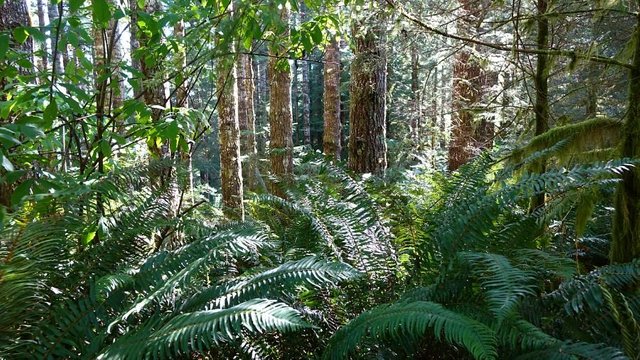 With the return of rain in September, and cooler temperatures, Oregon's mushroom season begins. I'm headed back to the Siuslaw National Forest, not far from the Pacific Ocean. Trip Date: September 22, 2017.
With the return of rain in September, and cooler temperatures, Oregon's mushroom season begins. I'm headed back to the Siuslaw National Forest, not far from the Pacific Ocean. Trip Date: September 22, 2017.
This is part of a series of foraging trips I made all through the autumn of 2017. I hope you will join me for the whole series -- especially if you like mushrooms! Earlier posts in this series are: Escape to the Marine Layer - Part 1 and Part 2. // Saunter in the Siuslaw - Part 1 and Part 2.

A Mighty Big Log!
I'm taking a different route to the forest today. At a little roadside rest area, there's a big, big log. I can tell it's a Douglas-fir tree from the layers in its thick bark.
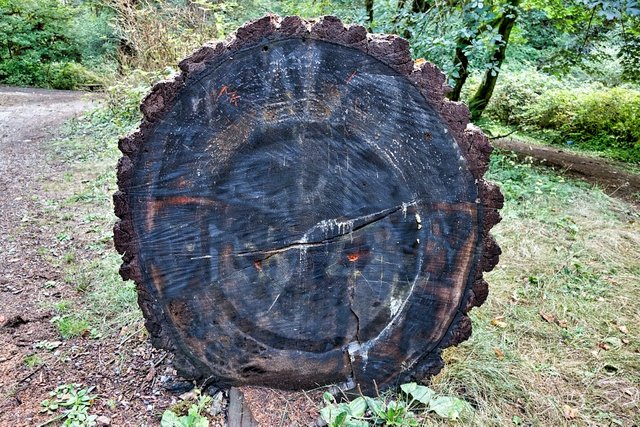 In this High Dynamic Range image, I can see why this log is still here. Somebody spray-painted "No Cut" on this log. I bet the rest of the tree was turned into lumber! But this part was left for us to appreciate Oregon's logging heritage.
In this High Dynamic Range image, I can see why this log is still here. Somebody spray-painted "No Cut" on this log. I bet the rest of the tree was turned into lumber! But this part was left for us to appreciate Oregon's logging heritage.
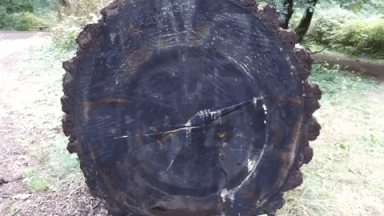 It's easy to see why "Doug-firs" are valuable timber trees. Look how uniform that log is! There's no taper in size from one end to the other, and there's no branches. That is a straight and clear bole there!
It's easy to see why "Doug-firs" are valuable timber trees. Look how uniform that log is! There's no taper in size from one end to the other, and there's no branches. That is a straight and clear bole there!
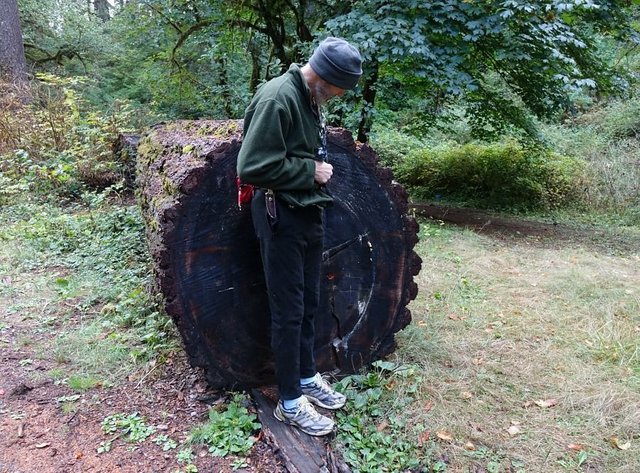 How big is that log? That fellow there is 6' 3"" tall (1.9 meters). So that log is over 4 feet in diameter! 1.2 meters!
How big is that log? That fellow there is 6' 3"" tall (1.9 meters). So that log is over 4 feet in diameter! 1.2 meters!
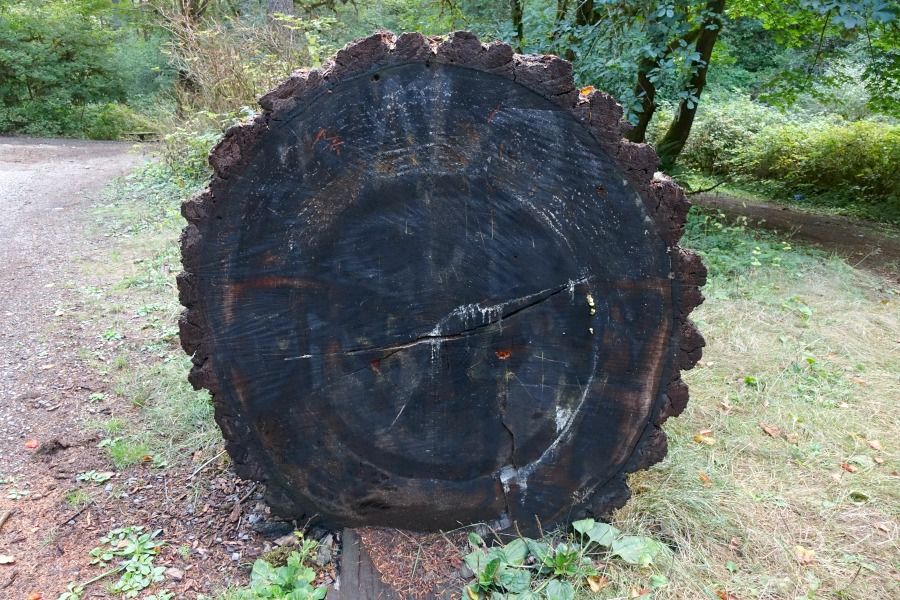 This is a more natural view of the log's cut end. Can you see the white stain in the lower right of the log? That's sap, just like we saw in a fresh-cut log in my Escape to the Marine Layer. Do you see anything else in the same growth ring as all that sap?
This is a more natural view of the log's cut end. Can you see the white stain in the lower right of the log? That's sap, just like we saw in a fresh-cut log in my Escape to the Marine Layer. Do you see anything else in the same growth ring as all that sap?

A Mighty Tiny Mushroom!
It's a tiny mushroom!
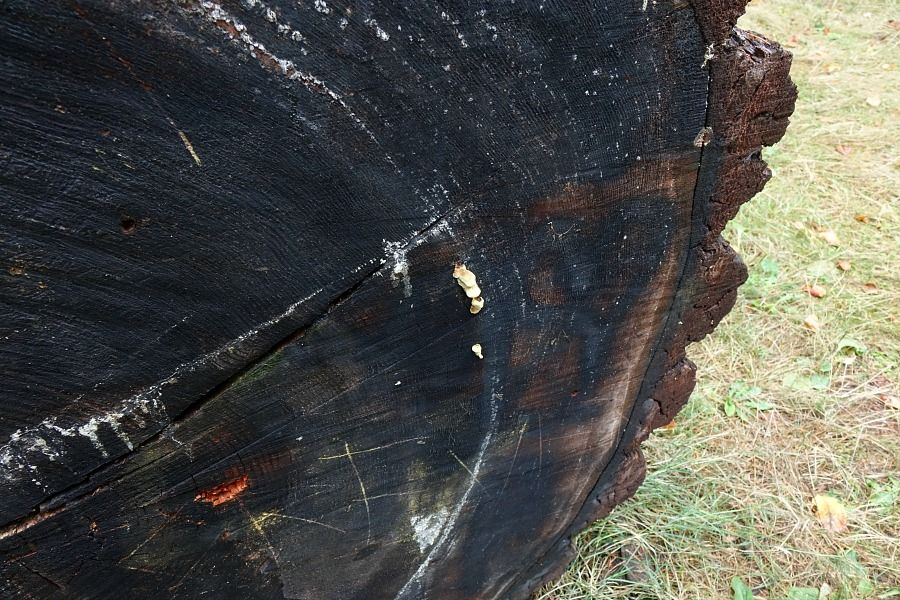 There's more here than meets the eye! Mushrooms are just the fruit of a fungus. There is a larger fungus growing inside that tree! It makes a mushroom when it has enough extra energy, and the weather conditions are just right.
There's more here than meets the eye! Mushrooms are just the fruit of a fungus. There is a larger fungus growing inside that tree! It makes a mushroom when it has enough extra energy, and the weather conditions are just right.
 Let's take a closer look. That mushroom is coming out from the layers with all the extra flowing sap.
Let's take a closer look. That mushroom is coming out from the layers with all the extra flowing sap.
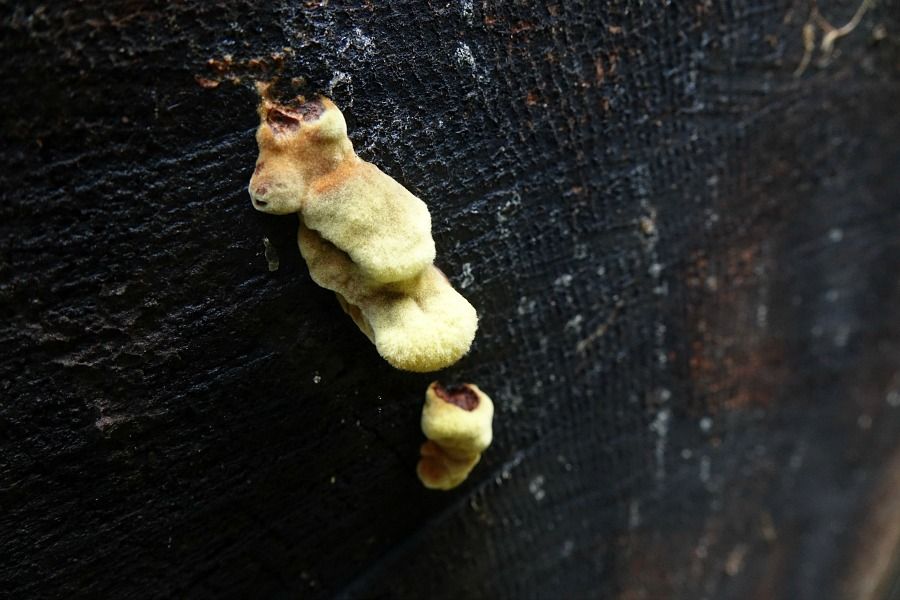 With its fuzzy yellow and orange surface, and how it's coming out as layers of mushrooms that are not quite a bracket shape (yet), it looks like a new Sulfur Shelf mushroom, also known as the Chicken of the Woods. The ones in Oregon are different species than the ones in the eastern US or Europe. Because this is growing on a Douglas-fir, a conifer, it's probably a Laetiporus conifericola[1,2], fine for eating. But this little new fungus fruit is not a good example for anyone learning to identify sulfur shelfs. And not for making any confident identification for eating, either. I'm leaving this little mushroom here.
With its fuzzy yellow and orange surface, and how it's coming out as layers of mushrooms that are not quite a bracket shape (yet), it looks like a new Sulfur Shelf mushroom, also known as the Chicken of the Woods. The ones in Oregon are different species than the ones in the eastern US or Europe. Because this is growing on a Douglas-fir, a conifer, it's probably a Laetiporus conifericola[1,2], fine for eating. But this little new fungus fruit is not a good example for anyone learning to identify sulfur shelfs. And not for making any confident identification for eating, either. I'm leaving this little mushroom here.

Another Mighty Tiny Mushroom on a Mighty Big Log!
Here's a different log in the same area, from a different tree. It looks like there's a different mushroom starting to grow, too!
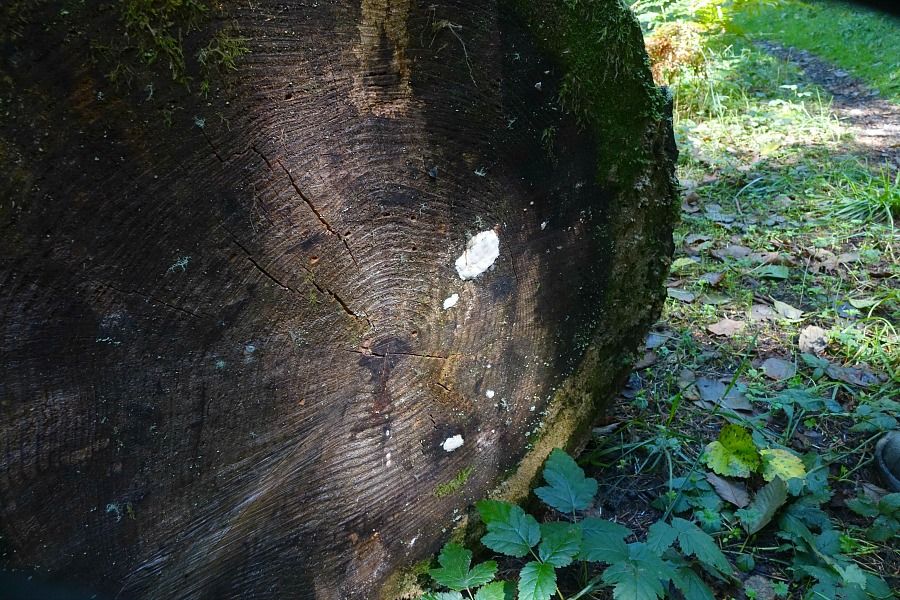 I see 3 patches of white mushrooms. But they sure don't look like a typical mushroom!
I see 3 patches of white mushrooms. But they sure don't look like a typical mushroom!
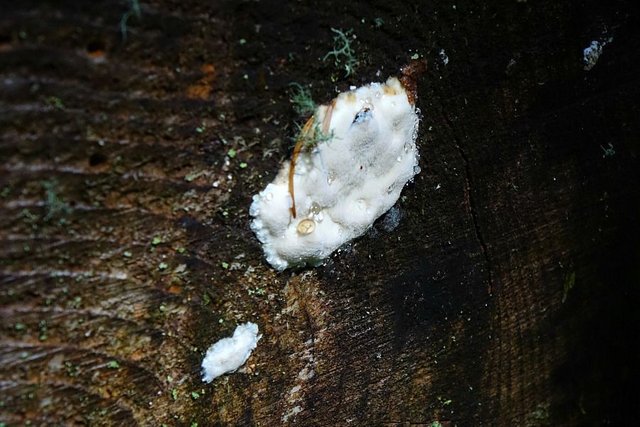 I can't tell what kind of fungus this is, just from this little mess. Some kinds of fungus never make any mushrooms at all, ever. And other kinds just make a crust, a smear, or a glob -- that's it. And others, like many of the bracket fungus, start out like this and then turn into their better-known forms. It is cool how this one is making those drops of water. That's not dew, but water pushed out by the fungus![3,4] It' a clear sign that this mushroom is actively growing -- the new mushroom season has certainly started! Yay!
I can't tell what kind of fungus this is, just from this little mess. Some kinds of fungus never make any mushrooms at all, ever. And other kinds just make a crust, a smear, or a glob -- that's it. And others, like many of the bracket fungus, start out like this and then turn into their better-known forms. It is cool how this one is making those drops of water. That's not dew, but water pushed out by the fungus![3,4] It' a clear sign that this mushroom is actively growing -- the new mushroom season has certainly started! Yay!

A Relaxing River
Aaahh, now we are at the Siuslaw River.
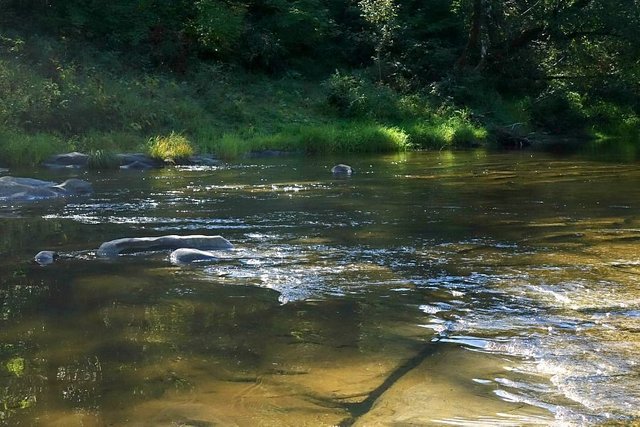 It's such a pleasant little stream in September. The water is clear and cold, coming out of the forest in the coastal mountains.
It's such a pleasant little stream in September. The water is clear and cold, coming out of the forest in the coastal mountains.
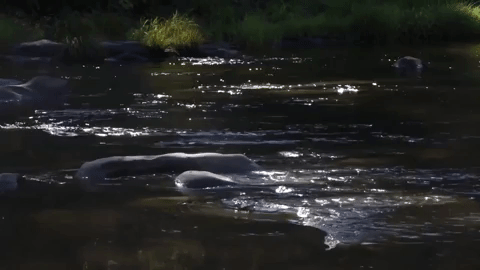 It sounds so relaxing. You will have to imagine that part yourself!
It sounds so relaxing. You will have to imagine that part yourself!
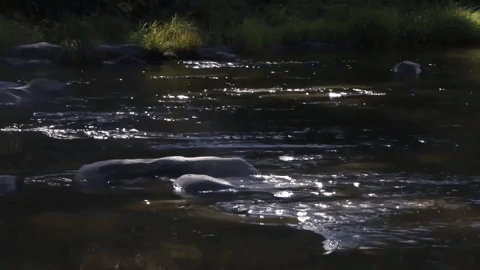 But the river is really big. By springtime, these rocks will be way underwater, from the winter snow and rain. This whole river channel will be full and flowing fast!
But the river is really big. By springtime, these rocks will be way underwater, from the winter snow and rain. This whole river channel will be full and flowing fast!

Soothing Moss
In the woods by the river, moss is starting to come back to life.
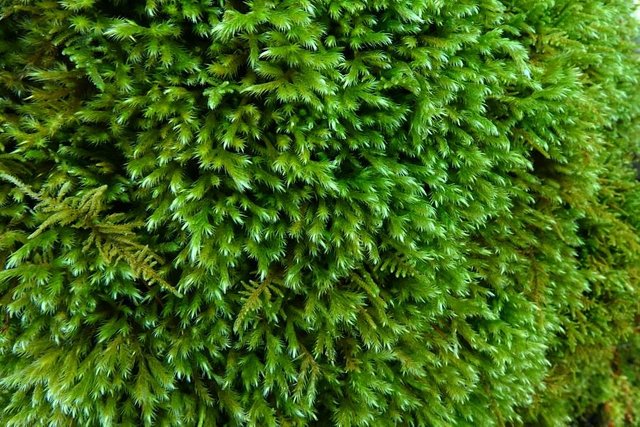 This moss is growing on the side of a tree. Read the next caption for a quick contest about moss and trees, with a prize!
This moss is growing on the side of a tree. Read the next caption for a quick contest about moss and trees, with a prize!
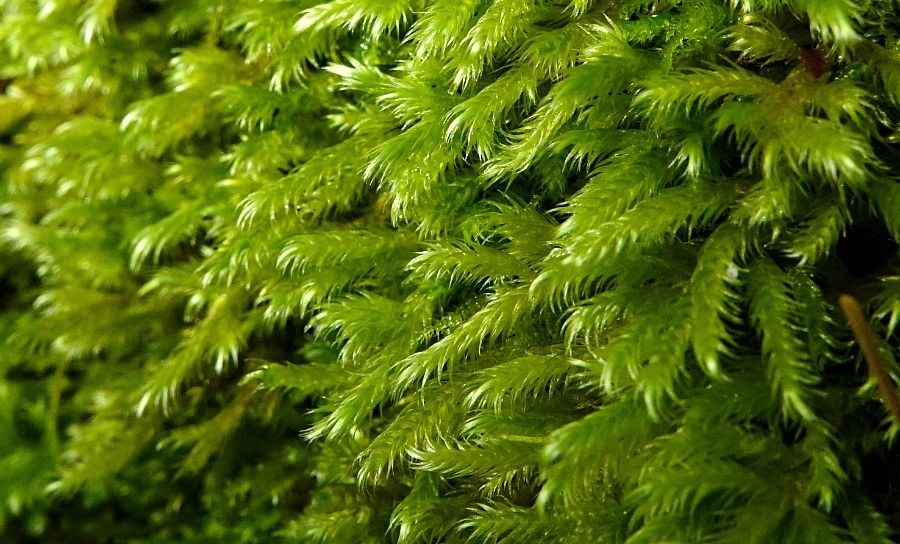 What side of a tree does moss grow on the best? Put your answer in the comments below. I'll draw a winner from the correct answers, at the end of the payout period for this post, for a $1 SBD prize.
What side of a tree does moss grow on the best? Put your answer in the comments below. I'll draw a winner from the correct answers, at the end of the payout period for this post, for a $1 SBD prize.

Thanks for Walking With Me!
Let's stop here, where we can listen to the sound of the river, appreciate the moss and think about that contest question. I hope you will join me for part 2 of this walk -- that's when we find the lobsters!
- What's the widest tree you have ever seen?
- What time of year do you notice mushrooms the most?
- What side of a tree does moss grow on the best? Let me know in the comments, to get in on the contest!

Plant List
- Douglas-fir - Pseudotsuga menziesii
- Sulfur shelf mushroom - Laetiporus conifericola
References:
1 - A good key to Sulfur shelf mushrooms: Kuo, M. (2017, November). The genus Laetiporus. Retrieved from the MushroomExpert.Com Web site: http://www.mushroomexpert.com/laetiporus.html
2 - Duffy, Toxic fungi of western North America
3 - Thornhill, 2014. Read it and weep: fungal guttation, Weird and Wonderful Wild Mushrooms, 24 August 2014.
4 - Parmasto and Voitk, 2010. Why do mushrooms weep? Fungi 3(4):15-17.
This post is on the Steemit World Map.
Haphazard Homestead
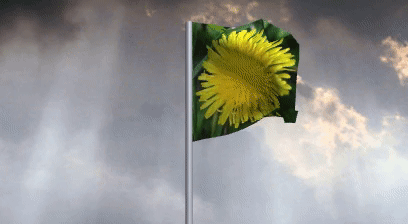 foraging, gardening, nature, simple living close to the land
All content is 100% Haphazard Homestead!My YouTube channel: Haphazard Homestead
foraging, gardening, nature, simple living close to the land
All content is 100% Haphazard Homestead!My YouTube channel: Haphazard Homestead























Here in Australia, it's Autumn going into Winter that we get mushrooms the most. We spotted some field mushrooms the other day, so we are getting pretty excited about the season. There's quite a few magic mushrooms in the forest too but we'll avoid them these days :) We haven't had a lot of rain, so when we do, I expect we'll go foraging. The Otway National park has some beautiful old trees. A lot of them were cut down by loggers back in the day but even then there are still many huge ones left. I love this one we spotted on our drive the other day - wouldn't it make an amazing coffee table (for giants!) with a sheet of glass over the top of it!! The shape of it is just fantastic - I think the root span pictured is probably 15 ft, and the girth of the actual tree wasn't quite so big of course - maybe only 6 ft across, but jeez it would have thumped when it landed.
That's a huge root wad! Can you imagine feeling the thump in the ground when that tree hit? It's amazing that the trees don't break when they hit the ground. Thanks for sharing -- and happy mushroom hunting!
It's called a root wad? That's cool. I know, I always wonder what they sound like when they fall!! I've never been lucky enough. Or unlucky - they can be very dangerous and every year people die from trees falling on them - I'd never camp under one in windy weather!
Moss grows on the shady side of the tree(to avoid moisture loss by sunlight)...
Depends upon the location, if you are in northern hemisphere moss grows in north direction and in southern hemisphere it grows south...
Thanks for giving an answer, @xabi! I'll let you know at the end of the contest! : )
Ah! Beautiful walk again with a lot of amazing things to see! The forest looks green and refreshing with those trees and the river. The water is clean and clear. Yes, this can make me feel relaxed indeed.
Oh! You can notice those little mushroom on the big logs. They are wonderful mushrooms.
The moss can exactly soothe me…. Let me guess… The moss grow at the bottom of the tree the best, right? ;D
haha -- that's an interesting answer about the moss, @tangmo! I think this is the first time you've entered an answer in any of my little contests. So I'm very happy about that! I'm glad you enjoyed relaxing along the river, too! :D
Ha ha! I'm glad to hear that you found my answer interesting..... Is it correct? ;)
Now we have not best season for mushrooms or for walking in the forest. Ground is still covered with snow, and I'm passsionately waiting that day when it will be possible to ride to the forest on a bicycle in search of snowdrops:-)
My answer to your question: moss grows best from that side of the tree where it has less sunrays and more moisture. It seems quite logical that it should be on the northern side. In addition, at school we were taught that the moss on the tree always points to the north, and this is a great way to navigate in the forest without a compass.
But in real life I had to see it on different sides of the tree. Sometimes I came across trees covered with moss from all sides, and it made me doubt the truthfulness of the school textbook. Maybe you can give explanation for this?
Btw, the log is just huge, I suppose that tree was no less than 50 years old. It's strange that they left so big and straight log to lay in the forest.
Your spring will happen eventually. Of course, that's easy for me to say, without being in the winter! You will appreciate your snowdrops, for sure!
I counted the growth rings of the tree -- and it's well more than 100 years just to where the little mushroom was growing! The rings are so close together because it grew in a mature forest. That is an old-growth forest and tree, for sure. The rings are so much farther apart these days, in the timber harvests from replanted forests.
I'll let you know about the moss! Thanks for venturing an answer!
The biggest trees I have ever seen are the Live oaks at Oak Alley plantation in Louisiana. Some of those trees were 29 feet around! I think I have more mushrooms here in the fall, although morels grow in the springtime, and I hope to find some. Depending on the growing conditions, moss can grow on any side of the tree. Love those moss photos!
Wow! That's a big tree! I think we have more mushrooms around here in the fall, too. There are still a lot more to come in this series of my fall hikes. Good luck with the morel hunting this spring! And thanks for entering my mini moss contest -- I'll let everyone know the answer soon! :D
In the northern hemisphere ... moss prefers the north side of the tree. You may get a few people from south of the equator saying the south side. They aren't wrong; just really lost. LOL. I kid.
Almost always one can find abundant fungus growing in our nearby forests. To me they are so beautiful with their oranges and yellows:)
That Douglas Fir was beaut. Looked like a piece of art.
The West Coast forests are such great places for mushrooms, for sure. And there really are seasons of the mushrooms, too, just like the wildflowers. I'll answer the moss question in a few days -- thanks for your reply. Enjoy all the big trees! :D
The weather is going to clear up tomorrow and then yes ... I am on it:)
That really puts it into perspective with a human next to a trunk!
There are even bigger tree trunks around here, too! I was chain-sawing some maple the other day and one chunk was so heavy. I can't imagine how much weight there is on the Earth where these big trees are. It must really shake the ground when they fall! =:O
You are ahead of me in Idaho, I was just thinking about 'shrooms... a few more weeks here though. For the tasty ones any way!
Oh, and since everyone else gave about the same answer I am going with "the outside." :)
Here on the western slope of the Cascades, I think we can have some mushrooms anytime there's moisture. The fall season has more variety here, but the springtime has some great ones. Here's to finding lots of morels in your area, too! And thanks for your moss answer. I'll let folks know soon! : )
Another magnificent post! I truly appreciate the knowledge you share and the polished format of your posts. Each one is like its own mini-encyclopedia, I love it ☺
To answer your question about moss, my answer is: moss grows best on the north side of trees
Thanks, enternamehere! I'm glad you enjoyed some time in the forest with me. Thanks for joining in the contest, too!
I wanna go home, love the loamy smell of the Douglas fir and cedar tree. I never had the courage to pick mushrooms, I don’t know enough, but our forest are full of yummy mushrooms.
Especially after all the wildfires this past summer, the loamy smell of the rain-soaked forest was so nice this fall! You have an eye for detail, so you would probably make a great mushroom forager! There sure are a lot of good ones here in western Oregon!